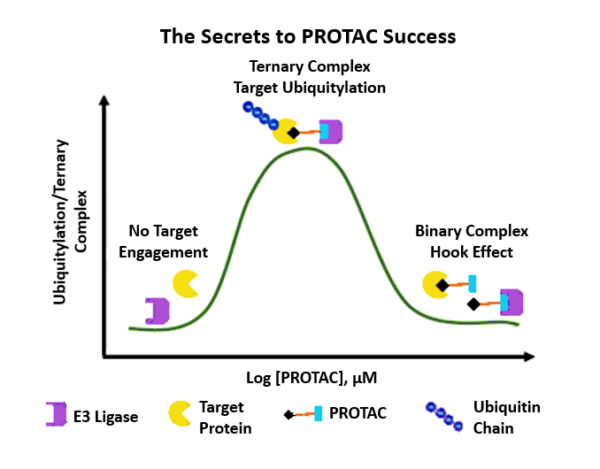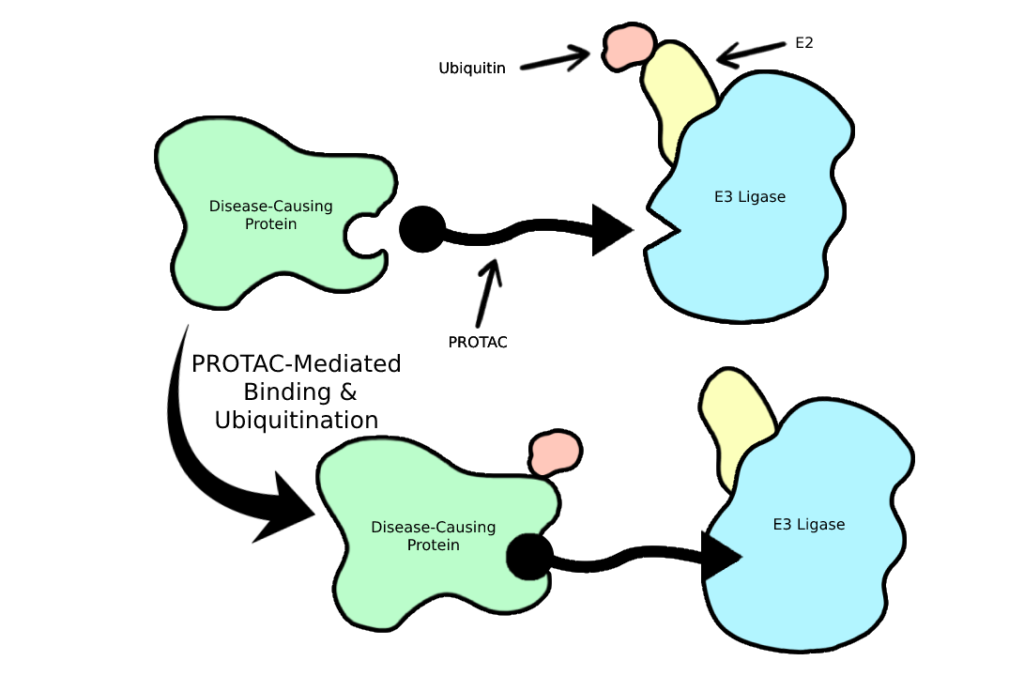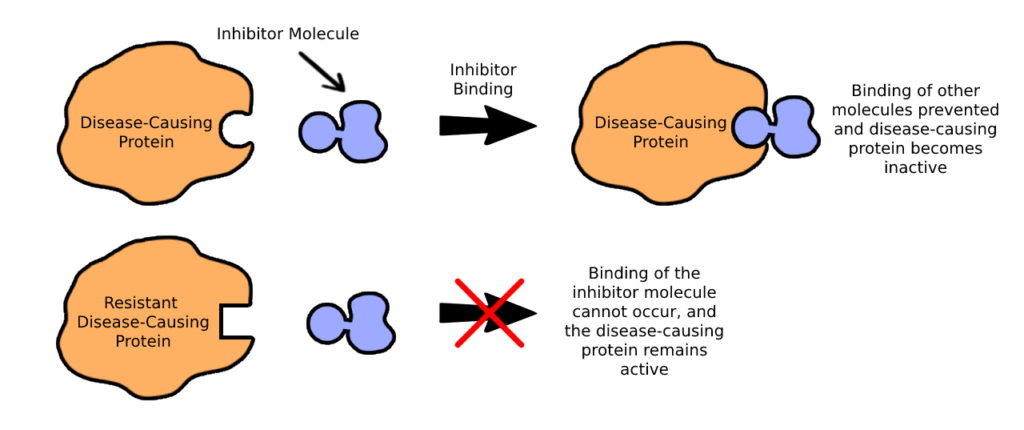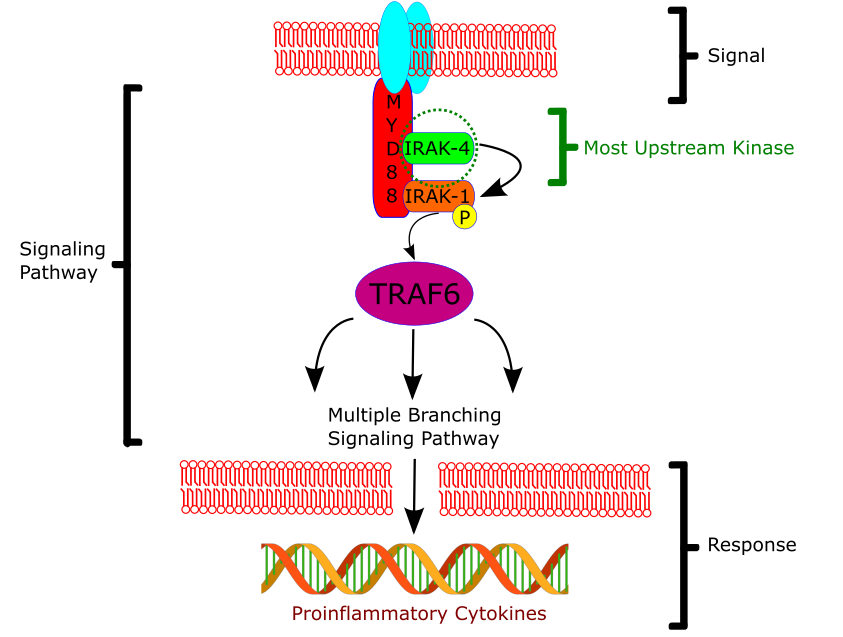
By: Rebekah Varghese, Derrick Padykula, & Jacob Huang
All the FDA-approved drugs combined interact with only 2% of the proteins found in human cells, according to Dr. Brent Stockwell, a professor at the Howard Hughes Medical Institute. It is truly disturbing to realize that many of the most devastating diseases, such as cancer, autoimmune disease, and neurodegenerative disease, are caused by proteins that are considered “undruggable” and that as many as 85% of the proteins in humans cannot be treated with traditional drugs.
It may seem like the pharmaceutical industry will eventually hit a dead end when attempting to develop novel traditional drugs to treat these devastating diseases. While this may be true for many diseases, there is an alternative to traditional drugs. PROTACs are a new class of drugs that will allow scientists and researchers to target supposedly “undruggable” proteins through unconventional means. PROTACs are drugs that bind selectively to the disease-causing protein, allowing your cells to degrade it naturally through a pathway known as the ubiquitin-proteasome pathway. A significant benefit of PROTACs is that your cells are highly unlikely to develop resistance to them, unlike many other drugs and chemical inhibitors since the target proteins are eliminated altogether, instead of just being inhibited.
 As shown in the figure above, a PROTAC acts as a linker, helping the E3 ligase enzyme mark the protein to be degraded. Imagine this process as leaving a sticky note on an item you want to put in the garbage. Anyone who comes across the item with the note will know to throw it out. This is exactly how the ubiquitin-proteasome system works, placing a marker to “throw out” a protein, and PROTACs increase the ease and speed of this process.
As shown in the figure above, a PROTAC acts as a linker, helping the E3 ligase enzyme mark the protein to be degraded. Imagine this process as leaving a sticky note on an item you want to put in the garbage. Anyone who comes across the item with the note will know to throw it out. This is exactly how the ubiquitin-proteasome system works, placing a marker to “throw out” a protein, and PROTACs increase the ease and speed of this process.
 One important application of PROTACs relates to cancer. KRAS is an important oncogene that is essentially an on/off switch for cell growth. However, the gene can become mutated, causing KRAS to be stuck in the on position, leading to uncontrolled cell growth, that is, cancer. This mutation is found in about 25% of tumors, driving “32% of lung cancers, 40% of colorectal cancers, and 85% to 90% of pancreatic cancer cases”. Normally, KRAS is considered “undruggable” since the protein is very tiny and doesn’t have easily accessible binding pockets. However, with a PROTAC approach, only engagement is required to begin the cascade of ubiquitin-mediated degradation. This innovative approach is currently being researched and optimized by many scientists, including those at LifeSensors.
One important application of PROTACs relates to cancer. KRAS is an important oncogene that is essentially an on/off switch for cell growth. However, the gene can become mutated, causing KRAS to be stuck in the on position, leading to uncontrolled cell growth, that is, cancer. This mutation is found in about 25% of tumors, driving “32% of lung cancers, 40% of colorectal cancers, and 85% to 90% of pancreatic cancer cases”. Normally, KRAS is considered “undruggable” since the protein is very tiny and doesn’t have easily accessible binding pockets. However, with a PROTAC approach, only engagement is required to begin the cascade of ubiquitin-mediated degradation. This innovative approach is currently being researched and optimized by many scientists, including those at LifeSensors.
Another promising area of PROTAC research is related to autoimmune disease. IRAK4 is a key molecule that participates in the innate immune response by being the most upstream kinase in the IL-1R and TLR signaling pathway. In some instances, this signaling pathway can become dysregulated leading to inappropriate overexpression of proinflammatory molecules (cytokines) that can cause diseases such as rheumatoid arthritis, eczema, and chronic skin disease. Currently, there are no therapeutics that can cure some of these autoimmune diseases because of the difficulty associated with designing “druggable” treatments in the IL-1R/TLRs signaling pathways. Exciting research utilizing PROTAC to mediate-degradation of IRAK4 can lead to effective treatments for autoimmune diseases. Companies have rapidly reached phase I clinical trials with a KT-474 PROTAC IRAK4 degrader and have so far produced promising results compared to traditional treatments. At LifeSensors, we are continuing to contribute by developing tools that support these PROTAC-related research.
 Another very important application for PROTACs relates to various neurodegenerative diseases, such as Alzheimer’s, Parkinson’s, and Huntington’s. Many of these terrible diseases involve proteins accumulating and misfolding, negatively affecting normal brain function. More specifically, these proteins are called tau and beta-amyloid for Alzheimer’s, alpha-synuclein for Parkinson’s, and huntingtin for Huntington’s. Traditional inhibitor drugs are not very effective at targeting these specific protein aggregates; however, with the PROTAC approach, their removal is possible with improved efficacy. At LifeSensors, we are currently working on developing PROTACs for these meaningful purposes.
Another very important application for PROTACs relates to various neurodegenerative diseases, such as Alzheimer’s, Parkinson’s, and Huntington’s. Many of these terrible diseases involve proteins accumulating and misfolding, negatively affecting normal brain function. More specifically, these proteins are called tau and beta-amyloid for Alzheimer’s, alpha-synuclein for Parkinson’s, and huntingtin for Huntington’s. Traditional inhibitor drugs are not very effective at targeting these specific protein aggregates; however, with the PROTAC approach, their removal is possible with improved efficacy. At LifeSensors, we are currently working on developing PROTACs for these meaningful purposes.
All these applications of PROTACs are the future of medicine, targeting diseases known to be “undruggable.” This technology will potentially allow us to tap into the other 85% of undruggable proteins. These developments are close on the horizon, so keep an eye out for more exciting news about PROTACs!
